May 1961 Popular Electronics
 Table of Contents Table of Contents
Wax nostalgic about and learn from the history of early electronics. See articles
from
Popular Electronics,
published October 1954 - April 1985. All copyrights are hereby acknowledged.
|
NASA is currently collecting
a phenomenal amount of data on the planet Mars. No small part of the effort is to
determine whether sending humans to inhabit Mars would be feasible, or even at all
possible. In order for it to be even possible for a long-term stay, it would be
necessary for consumable resources to be accessible by Earth Martians. Discovering
water ice would be the pièce de résistance since water is heavy and therefore very
expensive to transport across vast reaches of space. Another key bit of data needed
is frequency and size of meteor strikes on the surface since that figures directly
into survivability. Long before we had the capability or even need to do that for
Mars, NASA was doing the same sort of investigation on our moon (as opposed to one
of Mars' two moons, Phobos and Deimos). The resolution of telescopes, all ground-based
in the day, was good enough to perform site selection surveys in the x-y plane,
but altitude data could only be inferred via estimations based on shadow lengths
along the terminator (night/day line of demarcation) and sideways glances of peaks
and valleys. That was not good enough for planning a human expedition to the surface,
so engineers and scientists came up with a radar mapping technique to obtain z-axis
data. That effort is reported here in this May 1961 edition of Popular Electronics.
More information was needed prior to actually launching a Moon lander mission, including
sending unmanned orbiters and later manned orbiters to gather enough data to culminate
in the highly successful Apollo 11 mission in 1969 - just 8 years later.
Related articles: "How We Listen to Stars and Satellites" - January 1958 Popular
Electronics, "Radio Astronomy and the Jodrell Bank Radio Telescope" - February
1958 Radio & TV News, "Radio Astronomy - Low Noise Front-Ends" - June 1954 Radio &
Television News, "Radar
Explores the Moon" - May 1961 Popular Electronics, "Cosmic Radio Signals from Sun and Stars" - March 1948 Radio-Craft
Electronic engineers have developed unique methods to determine the roughness
of the lunar surface.
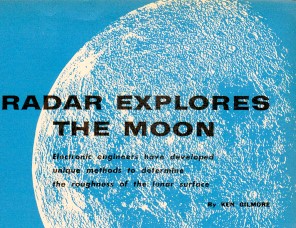 By Ken Gilmore By Ken Gilmore
Although man has not yet set foot on the surface
of the moon, Mars, or Venus, his radar "fingers" have already reached out and touched
these solar-system neighbors of ours.
We are getting important new information from our first electronic interplanetary
trips. Scientists recently learned for example, that Venus and other planets are
not quite as far away as we had thought. Further striking new advances in radar
equipment and spectacular progress in the techniques of analyzing and interpreting
radar echoes may soon bring answers to questions such as:
- How rough is the surface of the moon?
- Does Venus, eternally covered by its thick mantel of clouds, rotate as does
he earth - and if so, how fast? Does it have mountains, seas, icecaps, and forests?
- Is it true that the sun has a highly variable atmosphere of charged particles
which as some scientists theorize, reaches out beyond the earth?
- What does the dark side of Mercury look like?
- How dense are the ionized particles known to exist in space? how thick is the
cosmic dust endlessly drifting through the universe?
- After years of speculation, what are the mysterious "canals" of Mars?
Lunar color photos Underwood & Underwood
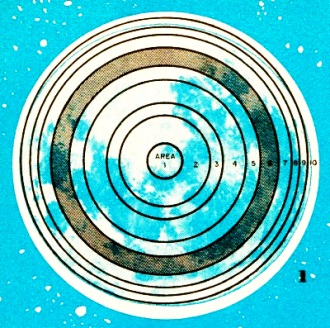 Fig. 1 - Each concentric ring shown represents
the lunar area capable of reflecting radar signals of specific millisecond time
delay.
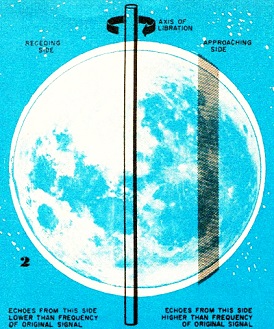
Fig. 2 - As the moon rotates, it also librates, so that radar echoes vary
above or below their radiated microwave frequency. Shaded section at right represents
a certain frequency band which is located above radiated frequency.
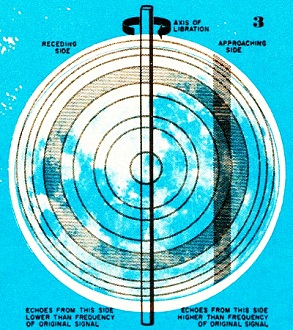
Fig. 3 - Combining both time delay and frequency selection tells us that
the radar echo came from a fixed area of the lunar surface.
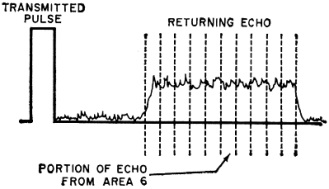
Lunar radar echoes are long in duration since the same narrow pulse must be reflected
from a spherical surface. The echo can be easily divided up into segments to match
those in Fig. 1.
Radar Astronomy.
The new branch of electronics seeking answers to these and related questions,
radar astronomy, is even younger than the more widely known radio astronomy - itself
no old-timer. Radio astronomy, touched off in 1931 when Karl Jansky discovered the
strange radio noises of the heavens, consists mainly of listening to the static
generated by ionized gas clouds and stars throughout the universe. In radar astronomy,
on the other hand, we send out the signals ourselves, then receive and record the
echoes when they come back.
It began in 1946 when the Army Signal Corps managed to bounce the first signal
off our closest heavenly neighbor, the moon. For the next decade, electronic techniques
and equipment improved-radar transmitters became more powerful, the receivers used
to detect the extremely weak echoes more sensitive. Finally, in early 1959, a group
of scientists at MIT's famous Lincoln Laboratory made radar contact with Venus.
Less than a year later, workers at Stanford University got echoes from the sun -
over 90 million miles away.
Until recently, all we could do with these radar contacts was measure distance.
We couldn't "see" much detail because radar beams, like light beams, spread out
as distance increases. The "tightest" beams are about one minute (1/60th of a degree)
wide. Also, the fineness of detail which the beam can distinguish depends on its
diameter at the target. When the target is at interplanetary distances, the beam
spreads thousands of miles. Thus it has about the same resolving power - detail-seeing
ability - as the human eye. You can see only the barest detail on the moon with
the unaided eye, and planets are simply pinpoints of light. They look about the
same to radar. Optical telescopes, on the other hand, can see far finer detail.
For some time, researchers have been looking for a way to improve radar's re-solving
power. The obvious method - narrowing the beam - wasn't practical. Even small improvements
would require tremendously large antennas. Finally, scientists at Lincoln Laboratory
came up with an ingenious plan for improving radar's resolution - without narrowing
the beam at all. With the new method, radar resolution now almost equals telescopic
resolution on the moon, and far surpasses it at interplanetary distances.
Listening for Echoes.
When we look at the moon, it seems to be a flat disc in the sky, although it
is really a sphere. The center of the sphere is closest to us, the outer edges farther
away.
When we bounce a radar signal off the moon, a strange thing happens. We send
out a pulse of one length, and get back a much longer echo. This is because part
of the signal bounces off the center (which is closest) , part bounces off some
distance away from the center, and so on, all the way out to the edge. It is as
though we were getting a series of echoes from a number of different targets, each
slightly farther away than the preceding one, so that all blend and overlap into
one long echo.
If we select a small part of the signal, say the first 1/10th that returns, we
know this is the echo from the moon's center. The next 1/10th will be from an area
surrounding the center slightly farther from us, and so on. By selecting various
parts of the echo, we can isolate echoes from various ring-shaped portions of the
moon's surface - see Fig. 1. The drawing to the right is an idealized representation
of how such an elongated return echo might look. The various parts of the echo are
from the numbered circular portions on the moon's surface.
We have now narrowed down the portion of the moon's surface from which the echoes
are coming, but for the system to be really useful in mapping the satellite by radar,
we must narrow it down still further. And in the moon's slight natural movement,
Lincoln Laboratory scientists found the key to doing just this. Although the face
of the moon does not rotate with respect to the earth - this is why we always see
the same side - it does wobble. Scientists call this wobbling "libration."
As the moon librates, it turns slightly in one direction, then back in the opposite
direction, and so on. As it librates in one direction, one outer edge is moving
toward earth; the other, away from us. Now, as a radar beam strikes the entire surface
of the moon, the echo which bounces off the side coming in our direction is slightly
raised in frequency, due to the Doppler effect. (This is the effect discovered many
years ago which seems to make a train whistle change in pitch as the train approaches,
then passes you.) The signal coming from the receding side is lowered in frequency.
The center, which remains at a constant distance, returns an echo at the same frequency
as the original signal
With various portions of the moon's surface returning echoes of different frequencies,
by tuning in only echoes of one frequency and rejecting the rest, we can listen
to echoes from any part individually. See Fig. 2. (The order reverses, but
the principle remains the same as the moon librates back in the opposite direction.)
By tuning only for one frequency, and at the same time selecting only one part
of the returning pulse, both of our selection systems are in operation. The only
echo we receive is from the two small spots on the moon where the two patterns overlap
- see Fig. 3.
Mapping the Moon.
Using this technique, scientists have made a rough radar map of the moon. Radar
pictures made in this way will never be as sharp as telescopic pictures of the moon
that we have had for years. But the system still has tremendous value. It can give
a pretty good idea of how rough certain parts of the moon's surface are - essential
information for a space ship landing.
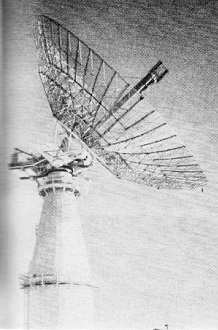 This antenna has been used in both the Venus
planetary radar contact and moon-mapping activity of MIT's Lincoln Laboratory.
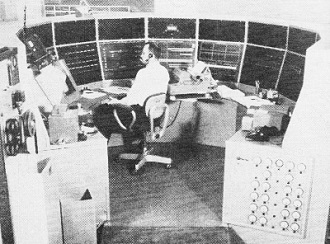
This computer at Lincoln Laboratory analyzed 10,000,000 computations to confirm
existence of weak radar echoes from Venus.

Intensity and time duration of the radar returns from Venus matched these two
curves prepared by the computer.
The primary value of the new radar mapping technique lies in the fact that while
the resolving power of a light telescope diminishes with distance, the resolving
power of the new radar telescope does not diminish with distance. Since the Doppler
and time delay effects used are functions of the size and speed of rotation of a
planet, and not its distance from earth) this radar system will resolve features
easily and accurately on Mars, Venus, Mercury, or any other planet our radar is
strong enough to reach. The moon is now serving to calibrate and test the system
so scientists can compare results with known terrain. Soon, radar eyes will be turned
on the planets.
The planets are millions of miles away and radio energy loses strength rapidly
as it travels through space. It follows the inverse square law, which means that
if you double the distance a signal has to travel, you end up with not one half,
but the square root of the power you had before. Since a radar signal has to travel
two ways - out to the target and then back - the strength of its signal diminishes
more rapidly. It varies inversely as the fourth power of the distance. In other
words, when you double the radar distance, you get back only 1/16th the power.
Mapping the Planets? To reach the planets and get a return echo, we need tremendous
amounts of transmitted power - all that we can generate. Even at maximum power,
the echo that comes back is not a sharp pip, easily received and spotted. All we
get from outer space is a lot of noise. Somewhere buried in that hash, we hope,
is the signal we want. But the signal may be as much as 10,000 times weaker than
the hash which is drowning it out.
Scientists are managing to solve the problem of detecting weak signals by sending
out a string of pulses, rather than one pulse, lasting - in the case of the Venus
contact, for example - just under five minutes. The return signal - a lot of hash
with some echoes mixed in - is fed to a computer which electronically adds up all
the areas where the pulses ought to be. Since the returning pulses are regular,
and the noise is irregular, theoretically the pulses will add up faster than the
noise. This theory actually works in practice. The computer, after making as many
as 10,000,000 separate computations, has spotted unmistakable echoes.
Radar astronomy, with its new techniques and improved equipment, will soon set
out on what may be the most spectacular job of its career: mapping the planets.
And when man himself actually leaves on his first trip, his travels will be far
safer, surer, and more valuable, because the fingers of radar astronomy will have
already paved the way for him.
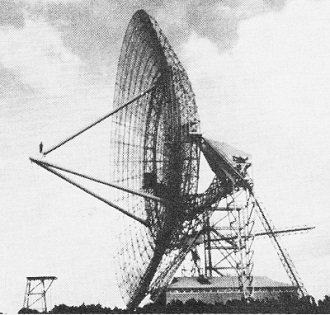
Working actively in the field of radar astronomy is the
Stanford Research Institute, Menlo Park, Calif. This 142·foot antenna, erected by
Stanford in northern Scotland, will be used for moon-echo studies similar to those
being made by Lincoln Laboratory.

Using techniques described in this article, scientists
at the Lincoln Laboratory have made this radar map of the moon.
When this system has been further improved, detailed maps of the surface of Mars
and Venus may be possible.
Posted January 11, 2023
(updated from original post on 8/5/2013)
|









 By Ken Gilmore
By Ken Gilmore








